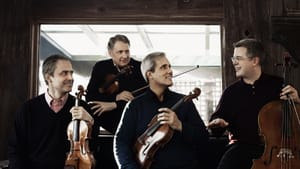Stay in the Loop
BSR publishes on a weekly schedule, with an email newsletter every Wednesday and Thursday morning. There’s no paywall, and subscribing is always free.
After 40 years, still on top of their game
PCMS presents the Emerson Quartet

The Emerson Quartet was named after Ralph Waldo Emerson, and like its namesake it has had staying power. Founded in 1976, it’s won about every honor around, and is America’s best-known chamber ensemble by a long shot. (We’re not counting Jefferson Airplane, the only other group I know of that was named after a philosopher.)
For its PCMS recital this year, the Emerson essayed two Romantic masterworks, Schubert’s Rosamunde Quartet and, with Roberto Diaz, Mendelssohn’s Quintet in B-flat, with Shostakovich’s Tenth Quartet sandwiched in between. All were beautifully played. The Emerson’s performances were tough and tensile once, but, without losing their force, they are mellower today.
This was particularly evident in the Schubert. The first of Schubert’s great trilogy of last quartets, the Rosamunde is a quintessentially Romantic work with melodies sublime even by Franzian standards, particularly in the first two movements. Schubert had shown his full maturity in his Quartettsatz, the single movement that has gone down as his Twelfth Quartet, but its successor, the Rosamunde, makes an astonishing statement in the rocking eight-note phrase that opens the work and encapsulates in its handful of notes the feeling-tone of the whole. The singing melody, the main theme of the Allegro ma non troppo, that follows springs from it as naturally as a lotus from its leaf. It is, for me, one of the first great moments of Romanticism, and yet the whole opening is a small miracle of concision worthy of any classical master. The Emerson let it unfold tenderly, and, throughout, played the work with a fine sense of its limpidity and proportion — as music that, for all its sentiment, is still deeply rooted in the Mozartean tradition.
A whirligig of a scherzo
The Shostakovich Tenth is the last of his mid-period works, because with the Eleventh we are already in the rarefied atmosphere of the composer’s late period, where the silences count for as much as the notes. The Tenth anticipates this style. It opens with a figure on the violin that seems to be hunting for its music rather than promising a theme; in this, it is the very opposite of the Rosamunde’s beginning, with its sense of perfect connection between introduction and melody. The other instruments weave a tune out of the figure, but the subject retains a provisional air, and it is only with development that it seems fully seated before fading to a close.
What follows is yet more unexpected: a whirligig of a scherzo that contains perhaps the most brutal and furiously paced music Shostakovich ever wrote. Quietude returns just as abruptly in the succeeding Adagio, which moves without pause into a typically extended finale that reprises earlier material, whips up a grim climax, and then lapses back toward silence. If the music makes a convincing whole, it does so on Shostakovich’s idiosyncratic terms, as a unity born of contrast and, for lack of a better word, skepticism about itself. Once again, the Emerson had the work firmly in hand, and, if it plays it with perhaps less raw drive than it once did, it is with the mature grasp of music long lived with.
Gone too soon
Felix Mendelssohn’s two string quintets — both, like their Mozartean predecessors, with a second viola — encapsulate his career. The Opus 18 A major, a brilliant and ebullient product of his teen years, yields pride of place only to the Octet Op. 20, probably the greatest work ever written by someone still shy of his 17th birthday. The work played on this night, the B-flat Quintet, Op. 87, is in contrast Mendelssohn’s last great chamber work, completed at what would be for him the ripe old age of 36. As with Schubert and Mozart, it makes us ache for what was denied us. We think of Mendelssohn as perpetually young, both for the nervous vivacity of his style and the amazing precocity of his career. But he was also a scholar and a savvy entrepreneur who, by the 1840s, was arguably the most important musical figure in Europe.
No work shows him more securely pointed at a new compositional depth and maturity that the B-flat Quintet, a work of symphonic richness and complexity that retains the delicacy and refinement of a true chamber style. We can only mourn the future we lost in Mendelssohn even as we marvel at the masterwork we have in Op. 87. That it is a work more prized by musicians and connoisseurs than the general public is the measure of how paradoxically undervalued one of the most familiar names in the classical repertory still is. Mendelssohn was not a boy genius who spent his gifts young but a figure busy shaping his time. As with his elder and even earlier-taken contemporary Schubert, it might have been a significantly different one had he been granted the longevity of a Berlioz, a Liszt, or a Wagner.
The Emerson, very ably assisted by Curtis institute President Roberto Diaz, himself a former principal violist of both the Philadelphia Orchestra and the National Symphony, threw themselves into the music with great zest and evident relish. The result was a performance as probing and rich as one could wish.
What, When, Where
The Emerson Quartet, with violist Roberto Diaz. Schubert, Quartet No. 13 in A minor, D. 804 (“Rosamunde”); Shostakovich, Quartet No. 10, Op. 118; Mendelssohn, Quintet in B-flat, Op. 87. Presented by the Philadelphia Chamber Music Society. February 5, 2016 at the Perelman Theater of the Kimmel Center, Broad and Locust Streets, Philadelphia. 215.569.8080 or pcmsconcerts.org
Sign up for our newsletter
All of the week's new articles, all in one place. Sign up for the free weekly BSR newsletters, and don't miss a conversation.

 Robert Zaller
Robert Zaller